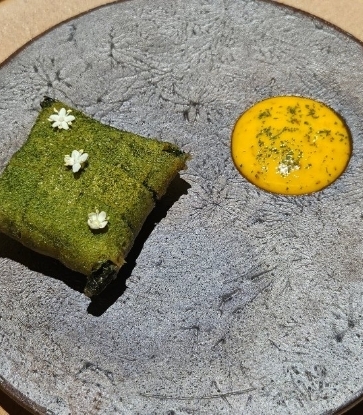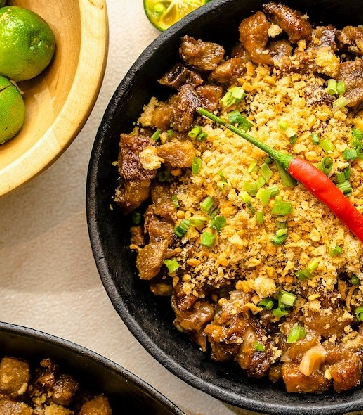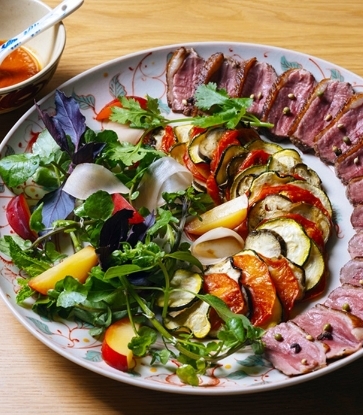Amidst the hustle and bustle of the food court at Cecil Street Market in George Town, Penang, stands a five-decade-old, family-run koay teow th’ng stall that attracts a steady line of customers every morning.
Lum Lai Duck Meat Koay Teow Th’ng is currently one of the most sought-after Bib Gourmand entries in the MICHELIN Guide Kuala Lumpur & Penang 2025, and it was founded in the late-70s by Lau Lum Lai, now 63, an itinerant hawker who peddled his wares from a pushcart that trawled the “Chit Tiau Lor” (7-Street) precinct, a working-class area within George Town.

Koay teow th’ng is a popular street food of Teochew origin. It consists of flat rice noodles steeped in a flavoursome, clear broth. There are three main variants of koay teow th’ng in Penang — a duck version, a pork version, and a chicken one.
Lau chose to offer the duck version, as his source of inspiration was the popular duck-meat koay teow th’ng places along Kimberley Street, in the heart of George Town’s old Chinatown. Local Penangites call the street “Swatow Kay”, meaning “Swatow Street” in Hokkien, alluding to the proliferation of Teochew immigrants from Swatow who had settled there since the 19th-century. Duck has always the the choice of meat for the Teochews.

The broth is prepared by slow-simmering whole ducks, pork bones, pig’s intestines, and pork loin for at least two hours. Lau explains that the addition of pork complements the flavours of the duck, as it adds a gentle sweetness that soothes the edgy assertiveness of the duck meat. No chicken is used as, according to Lau, it'll change the taste profile of the broth completely.
Once cooked, the whole ducks used for the broth will be retrieved, deboned, and the meat shredded, to be used as garnishing for the finished product. Other accompaniments include fish balls, slivers of fish cake, pork, pig’s intestines, and pig’s liver. Duck wings, webbed feet, and necks are also available as extra side orders.
Lau Wei Loon is the main person running the stall nowadays, as the older Lau steps back and is content to remain in the background. Having helped his father since the age of 14, the boyish-looking Wei Loon has had 22 years of experience under his belt by now.
Watching the younger Lau prepare a standard bowl of koay teow th’ng is mesmerising — working with deftness and at a breathtaking speed, there is a certain economy of movement as his hands dart across the various ingredient trays on preparation counter: he reaches out to pull a clump of koay teow noodles, throws it into a vat of boiling water to heat it up, scoops up the blanched noodles, and gives them a vehement shake to rid them of any excess water before tossing them into the serving bowl.
He picks up and applies the garnishes to the serving bowls with the precision and accuracy of a casino croupier dealing out cards. Each bowl is finished off with a light shake of white pepper, a quick spoonful lashing of soy sauce, some chopped scallions, and a dollop of delicious golden-fried garlic with lard.
We sat down with Lau Lum Lai to learn more about Lum Lai Duck Meat Koay Teow Th’ng and how they manage their family business.

Tell us how the business started.
I started this koay teow th’ng business back in the late-1970 to help my father — that was nearly 50 years ago now, and I was just in my teens! I started selling koay teow th’ng from a pushcart and I would do my rounds through the “Chit-Tiau-Lor” (Seven Road) precinct, a rough working-class neighbourhood at the time. I was actually doing very well in school and was enrolled in one of the top Chinese schools in Penang, but I felt that my calling was to help my family.
How did you come up with your koay teow th’ng recipe?
I am proud to say the recipe was developed by me through years of trial-and-error. No master chef was involved, as I believe they never share all their knowledge. Over decades, I perfected the duck broth recipe and have since passed it to my son, who now runs the business.

How do you manage your business?
Our priority is maintaining the authentic flavours of our koay teow th’ng by sourcing essential ingredients. Due to government regulations, we now procure freshly slaughtered ducks from mainland Penang and have stopped offering blood pudding as a garnish.
Having family members help run the business reduces reliance on unpredictable foreign labour, too, it also helps ensure our offering is consistent in quality and taste.
Our top priority is to ensure consistency in our offerings. We want to make sure that we maintain our product’s value. We occasionally get questions about expansion plans; however, if, by expanding, it means “losing control", for example, letting someone else cook the food, then, it is a risk we are not prepared to take at the moment.
What is the secret to keeping the broth clear?
Our broth is freshly prepared by slow-simmering ducks, pork, and pork ribs over low to medium heat for at least two hours, keeping it clear. We cook two batches daily: one at 5:00 a.m., ready by 7:00 a.m., and another at 11:00 a.m.
Why did you specifically choose to focus on duck? What difference does it make to the soup base?
Back in the 1970s, the Teochew-run duck-meat koay teow th’ng stalls in Swatow Kay set the standard as being the best in town. So, it was a natural choice for me to base my koay teow th’ng broth on duck meat. People just love it.
What is the best way to enjoy the Duck Meat Koay Teow Th'ng you serve?
Just tuck in and enjoy your bowl of noodles any way you want — that is the joy of eating koay teow th’ng: no particular method to follow.
We also provide a small saucer of soy sauce with cut red chillies as a dip on the side, as most customers love a spike of heat to spice up their koay teow th’ng. Many customers also love having a cup of local Hainanese coffee or milk tea to go with their koay teow th’ng.

Do you continuously monitor the cooking to ensure consistency and find ways to improve it?
Yes, of course. It’s quite easy in our case as only my son, Wei Loon, and I do all the cooking. We never take shortcuts, and we make sure the flavours and textures of our end-product are consistently good, in order to pass the taste-test of our regulars.
At the end of the day, they are the ultimate judges of our offerings — they are the ones who can make or break our business. If they like our koay teow th’ng, the queues will always be there.
Every good koay teow th’ng vendor in Penang is successful for their own reasons. For us, we put our heart and soul into our cooking. We also use only the best ingredients at all times. Our family motto is “To serve the customers with sincerity, and from our hearts”.
Being recognised by the MICHELIN Guide, and being included in the Bib Gourmand selection brings my family great pride and happiness. It shows that our food transcends different cultural and culinary boundaries.
We welcome everyone to come taste our koay teow th’ng and judge for yourself why ours is so special.





















